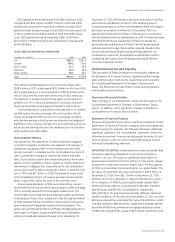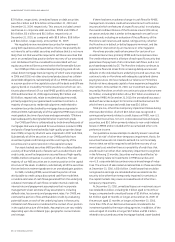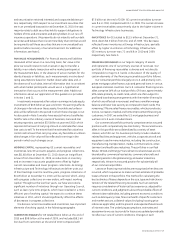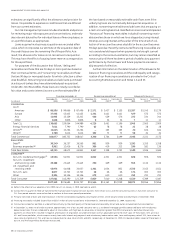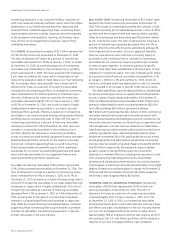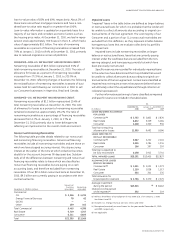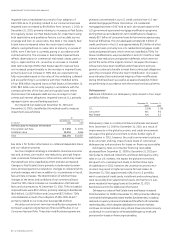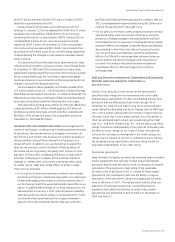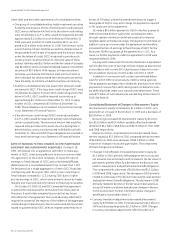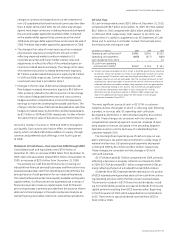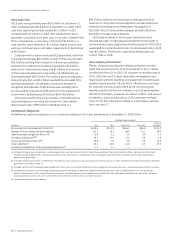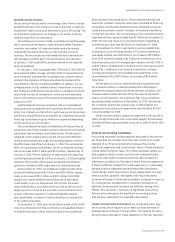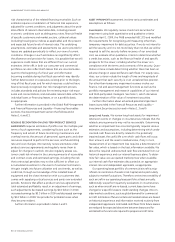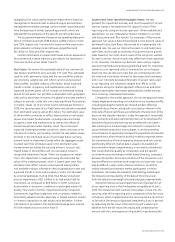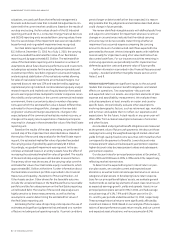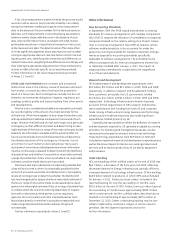GE 2010 Annual Report Download - page 56
Download and view the complete annual report
Please find page 56 of the 2010 GE annual report below. You can navigate through the pages in the report by either clicking on the pages listed below, or by using the keyword search tool below to find specific information within the annual report.management’s discussion and analsis
54 GE 2010 ANNUAL REPORT
GECS liquidity and funding plans are designed to meet GECS’
funding requirements under normal and stress scenarios, which
include primarily extensions of credit, payroll, principal payments
on outstanding borrowings, interest on borrowings, dividends to
GE, and general obligations such as operating expenses, collateral
deposits held or collateral posted to counterparties. GECS’ fund-
ing plan also has been developed in connection with our strategy
to reduce our ending net investment in GE Capital. GECS relies on
cash generated through collection of principal, interest and other
payments on our existing portfolio of loans and leases, sales of
assets, and unsecured and secured funding sources, including
commercial paper, term debt, bank borrowings, securitization and
other retail funding products.
Our 2011 GECS funding plan anticipates repayment of principal
on outstanding short-term borrowings, including the current
portion of our long-term debt ($118.8 billion at December 31,
2010), through issuance of commercial paper and long-term debt,
cash on hand, collections of financing receivables exceeding
originations, dispositions, asset sales, and deposits and alterna-
tive sources of funding. Interest on borrowings is primarily repaid
through interest earned on existing financing receivables. During
2010, GECS earned interest income on financing receivables
of $24.1 billion, which more than offset interest expense of
$15.0 billion.
Both the GECS Board of Directors and the GE Audit Committee
have approved a detailed liquidity policy for GECS, which includes
a requirement to maintain a contingency funding plan. The liquid-
ity policy defines GECS’ liquidity risk tolerance under different
scenarios based on its liquidity sources and also establishes
procedures to escalate potential issues. We actively monitor GECS’
access to funding markets and liquidity profile through tracking
external indicators and testing various stress scenarios. The
contingency funding plan provides a framework for handling
market disruptions and establishes escalation procedures in
the event that such events or circumstances arise.
Actions taken to strengthen and maintain our liquidity are
described in the following section.
Liquidity Sources
We maintain liquidity sources that consist of cash and equiva-
lents and a portfolio of high-quality, liquid investments (Liquidity
Portfolio) and committed unused credit lines.
We have cash and equivalents of $79.0 billion at December 31,
2010, which is available to meet our needs. A substantial portion
of this is freely available. About $10 billion is in regulated entities
and is subject to regulatory restrictions or is in restricted coun-
tries. About $18 billion is held outside the U.S. and is available to
fund operations and other growth of non-U.S. subsidiaries; it is
also available to fund our needs in the U.S. on a short-term basis
without being subject to U.S. tax. We anticipate that we will con-
tinue to generate cash from operating activities in the future,
which will be available to help meet our liquidity needs.
In addition to our $79 billion of cash and equivalents, we have
a centrally managed portfolio of high-quality, liquid investments
with a fair value of $2.9 billion at December 31, 2010. The Liquidity
Portfolio is used to manage liquidity and meet the operating
needs of GECS under both normal and stress scenarios. The
investments consist of unencumbered U.S. government securi-
ties, U.S. agency securities, securities guaranteed by the
government, supranational securities, and a select group of
non-U.S. government securities. We believe that we can readily
obtain cash for these securities, even in stressed market conditions.
We have committed, unused credit lines totaling $51.8 billion
that have been extended to us by 58 financial institutions at
December 31, 2010. These lines include $35.6 billion of revolving
credit agreements under which we can borrow funds for periods
exceeding one year. Additionally, $16.2 billion are 364-day lines
that contain a term-out feature that allows us to extend borrow-
ings for one year from the date of expiration of the lending
agreement. During 2010, we renewed all of the 364-day lines
and we extended the term of $23 billion of multi-year lines by
one year to 2013.
At December 31, 2010, our aggregate cash and equivalents
and committed credit lines were more than twice GECS’ com-
mercial paper borrowings balance.
Funding Plan
Our strategy has been to reduce our ending net investment
in GE Capital. In 2010, we reduced our GE Capital ending net
investment, excluding cash and equivalents, from $526 billion
at January 1, 2010 to $477 billion at December 31, 2010.
In 2010, we completed issuances of $25 billion of senior, unse-
cured debt with maturities up to 17 years (and subsequent to
December 31, 2010, an additional $11 billion). Average commercial
paper borrowings for GECS and GE during the fourth quarter were
$40.1 billion and $6.0 billion, respectively, and the maximum
amount of commercial paper borrowings outstanding for GECS
and GE during the fourth quarter was $42.4 billion and $7.2 billion,
respectively. GECS commercial paper maturities are funded prin-
cipally through new issuances and at GE are repaid by quarter-end
using available cash.
Under the Federal Deposit Insurance Corporation’s (FDIC)
Temporary Liquidity Guarantee Program (TLGP), the FDIC guaran-
teed certain senior, unsecured debt issued by GECC on or before
October 31, 2009, for which we incurred $2.3 billion of fees for our
participation. Our TLGP-guaranteed debt has remaining maturi-
ties of $18 billion in 2011 ($2.5 billion matured in January 2011)
and $35 billion in 2012. We anticipate funding these and our other
long-term debt maturities through a combination of existing cash,
new debt issuances, collections exceeding originations, disposi-
tions, asset sales, deposits and alternative sources of funding.
GECC and GE are parties to an Eligible Entity Designation Agreement
and GECC is subject to the terms of a Master Agreement, each
entered into with the FDIC. The terms of these agreements include,
among other things, a requirement that GE and GECC reimburse



